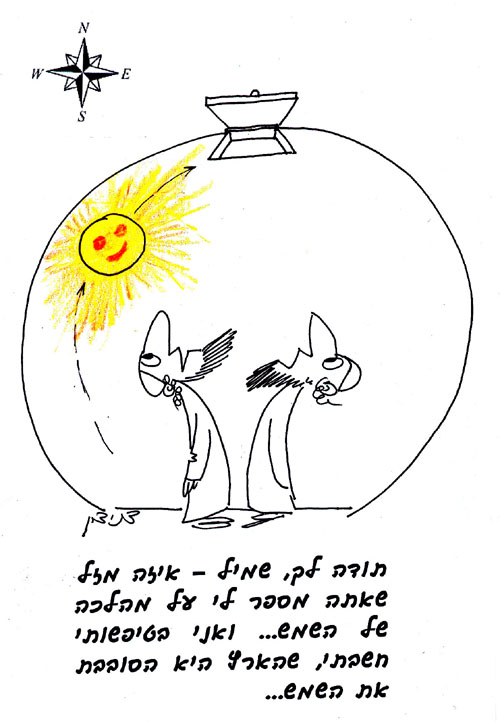
According to the early sages (Tanaaim), the earth is flat and covered by the firmament, which serves as walls and a roof, a sort of covered room — and people walk upon the earth as though in a closed room. The early sages were divided on the manner in which the firmament covers the earth. According to the sage Rabbi Elazar the firmament covers three sides and only the north side is open to space. Therefore, in his opinion, the sun travels so: The sun enters the thickness of the firmament on the east side, through the window, and begins to shed light upon the earth. It travels to the south and continues west, from whence it exits through a window in the firmament (causing darkness to descend because the thickness of the firmament serves as a barricade blocking the rays of the sun). After it exits the west side the sun rises above the firmament but does not go north, for otherwise the sun would shed light upon the earth, as there is no wall on the north side. Therefore, in his opinion, since the north side is open to space, the north wind is very cold. Thus did he explain the verse in Job “From the chamber of the south comes the whirlwind, and cold from the scattering winds of the north. By the breath of G-d ice is given, and the broad waters are frozen” (Job 37:9-10). From the chamber of the south comes the whirlwind — the whirlwind comes from the south because that side is covered on all sides, like a room, by the firmament, and cold from the scattering winds of the north — the north wind is cold because that side is open to space. By the breath of G-d ice is given — the west wind, and the broad waters are frozen — the east wind. The scholars ask: From the words of the early sage above we see that the south wind is a whirlwind, a damaging wind. But from the words of a different sage we see that the south wind is beneficial and causes the rains, which benefit the farmers. Answer: The south wind is harmful when hard rains fall and good and beneficial when gentle rains fall.
According to the sage Rabbi Joshua the thickness of the firmament covers Earth on all sides, including the north. Therefore, in his opinion, when the sun exits the window on the west side it continues its journey north and from there to the east side. This is even supported by the verse in Ecclesiastes: ” The sun also rises, and the sun goes down, and hastens to the place where it arose. The wind goes toward the south, and turns around to the north; the wind whirls about continually, and comes again on its circuit” (Ecclesiastes 1:5-6). In his opinion the word “goes” means that the sun slips under the firmament and shines upon the world. The word “turns” means that the sun goes above the firmament on the north, and so there is darkness. Thus does he explain the verse: goes toward the south — during the day, and turns around to the north — at night, the wind whirls about continually, and comes again on its circuit — on the east and west sides, where sometimes the sun is under the firmament and sometimes above, depending on where the sun enters and exits the thickness of the firmament. In the winter, when days are short, the sun enters the thickness of the firmament on the southwest side and continues along the west side until it reaches the north. The sun is sometimes above the firmament and sometimes beneath it on the west and the south sides.
(Babylonian Talmud, Tractate Bava Batra 25 a-b)
